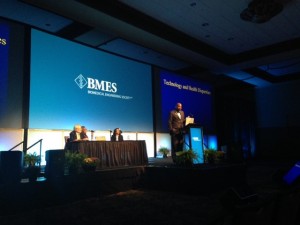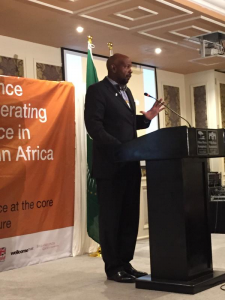 On October 8, I had the great honor to co-chair a special session with Dr. Gilda Barabino for the 25th Biomedical Engineering Society Meeting in Tampa, FL. The session was entitled “Biomedical Engineering Technology for the Elimination of Health Disparities.” The goal of this session was exploring the roles of various biomedical engineering technologies for use in eliminating health disparities. Topics included the use of technologies for addressing musculoskeletal conditions such as arthritis and osteoporosis, new emerging technologies involving mobile health (mhealth) which present possibilities for treatment of diabetes and hypertension. The session also addressed the use of biomedical technologies in developing countries, with an eye toward the adaptation of technologies to address issues here in the U.S. The 2015 BME Innovation and Career Development Travel Award winners were also announced at the session.
On October 8, I had the great honor to co-chair a special session with Dr. Gilda Barabino for the 25th Biomedical Engineering Society Meeting in Tampa, FL. The session was entitled “Biomedical Engineering Technology for the Elimination of Health Disparities.” The goal of this session was exploring the roles of various biomedical engineering technologies for use in eliminating health disparities. Topics included the use of technologies for addressing musculoskeletal conditions such as arthritis and osteoporosis, new emerging technologies involving mobile health (mhealth) which present possibilities for treatment of diabetes and hypertension. The session also addressed the use of biomedical technologies in developing countries, with an eye toward the adaptation of technologies to address issues here in the U.S. The 2015 BME Innovation and Career Development Travel Award winners were also announced at the session.
Month: November 2015
AESA Launch in Kenya
 In March, 2015, the African Union supported the establishment of the Alliance for Accelerating Excellence in Science in Africa (AESA) under the leadership of the African Academy of Sciences and the New Partnership for Africa’s Development. AESA will help drive Africa’s research agenda and build scientific capacity across the continent. The Wellcome Trust, the Bill and Melinda Gates Foundation, and the UK Department for International Development are funding the development of AESA and sharing their vision of supporting the next generation of African researchers who will help solve some of the continent’s greatest health and development challenges.
In March, 2015, the African Union supported the establishment of the Alliance for Accelerating Excellence in Science in Africa (AESA) under the leadership of the African Academy of Sciences and the New Partnership for Africa’s Development. AESA will help drive Africa’s research agenda and build scientific capacity across the continent. The Wellcome Trust, the Bill and Melinda Gates Foundation, and the UK Department for International Development are funding the development of AESA and sharing their vision of supporting the next generation of African researchers who will help solve some of the continent’s greatest health and development challenges.
In early September, I was honored to receive an invitation to attend the AESA launch in Nairobi. I delivered a speech during which I read a letter from Dr. Francis Collins, the Director of NIH, in support of AESA. As a African-American, I am very proud Africa will play a key role in building a world-class scientific and programmatic unit.
India National Academy of Sciences
I am happy to announce that I have been elected a Foreign Fellow of the India National Academy of Sciences. I am one of only two Foreign Fellows elected this year, and the first from the University of Connecticut and UConn Health.
The citation reads “for his pioneering work in the field of material sciences.” I was recognized as a world leader in polymer-ceramic composites, and recognized for his contributions in tissue generation and bioengineering.
Election to the India National Academy of Sciences is a tremendous honor. I feel so fortunate to have had the support of all my colleagues, my students and the organizations I have worked with. My election is a tribute to their support.
The National Academy of Sciences in India was founded in 1930 and it is the oldest Science Academy in India. It is located in Allahabad, Uttar Pradesh. The main objective of the Academy was to provide a national forum for the publication of research work carried out by Indian scientists and to provide opportunities for exchange of views among them.